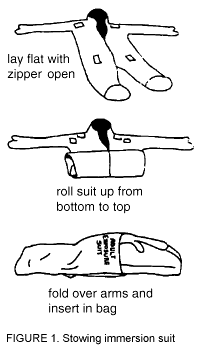Hypothermia, the lowering of a person's core body temperature, can be a killer for anyone who works or plays outdoors.
Commercial fishermen working away from shore in cold weather have little chance of survival if they fall overboard or have to abandon a sinking ship. Humans rapidly lose heat in cold water and can die in a matter of minutes.
Immersion suits, or survival suits as they are often called by commercial fishermen, can significantly improve survival time in cold water. These suits are often featured in stories about successful sea rescues. Recognizing that hypothermia is a major factor in lives lost at sea, the U.S. Coast Guard now requires immersion suits on documented vessels operating north of 32 degrees North and seaward of the Coastal Boundary Line.
Notwithstanding any requirements, immersion suits are recognized as an important piece of life saving equipment for all fishermen. To be effective, fishermen must keep their suits in good condition, keep them handy and know how to use them.
Proper care and maintenance of immersion suits will extend their working life and possibly your own. Routine suit inspections should include suit material and function of zippers and inflation hoses.

Your immersion suit works properly only when you are wearing it in the water. New safety regulations for documented vessels that operate beyond the boundary lines or with more than 16 people, require monthly drills and instructions for donning immersion suits. First attempts can be awkward and exhausting but with practice you should succeed in getting into a suit in one minute or less. Practice seated donning of suit. This will be the most convenient methods in actual high sea, emergency situation. The following is the instructions for practice seated donning of an Immersion Suit (Figure 2):

STEP 1. Roll suit out on deck and sit on it. Insert your legs into suit using plastic bags to make it easier. Leave on boots and other clothing for insulation and protection in the water.
STEP 2. Place non-dominant arm into suit first (lefties-right and righties-left). Pull hood over head with free hand.
STEP 3. Place dominant arm in last. Pull the zipper up with care and secure flap over your face.
STEP 4. Make sure that all straps and hoses are secure to avoid being snagged or injured. Do not inflate air bladder until you are in the water.
A training variation on this procedure would be to try putting the suit on in the water. Sit on top the suit and slide in one leg at a time. Next insert one arm, put hood over head and then the other arm. Your suit may now be filled with water but your body heat will warm it up.
As of September 15, 1991, the Coast Guard requires all suits to be marked with 31 square inches of retro-reflective material Tape I and II. This will improve your visibility and chances of being picked up. All Coast Guard Approved suits come with the correct amount of retro-reflective tap and should not need any additional. A whistle and strobe light (as required on ocean going vessels) will also help. Suits must be equipped with a Coast Guard Approved PFD light which should be attached to the shoulder area, and have an up-to-date power supply. Suits must also be marked in "block capital letters" with (a) the vessel name, (b) the name of owner of the suit, or (c) the name of the person to whom the suit is assigned. Check with manufacturer for proper paint or magic marker for your suit.
For proper functioning, be sure your suit fits properly. Check the seams, equipment and fit in your monthly drills. Make repairs immediately. Your life could depend on it.
If you have questions about care of your suit or regulatory requirements, contact the manufacturer or U.S. Coast Guard.
Additional Information:
Stewart M. Tweed - Marine Extension Agent - New Jersey Marine Advisory Service
Mr. Richard C. Hiscock is acknowledged for review of this Fact Sheet.
This publication was made possible in part by a grant from the National Institute for Occupational Safety and Health Program on Agricultural Health Promotion Systems for New Jersey.
Disclaimer and Reproduction Information: Information in NASD does not represent NIOSH policy. Information included in NASD appears by permission of the author and/or copyright holder. More